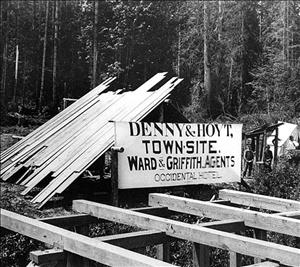Fremont, one of Seattle's liveliest neighborhoods, modestly calls itself "the Center of the Universe." Located north of the Ship Canal that connects Lake Union with Puget Sound, it is home to sculptural curiosities and a lively mix of bistros, artist studios, boutiques, and coffee shops. Starting out as cluster of small industries on the north Lake Union shore, it prospered from railroads and trolleys and went into decline when passenger transit faded out in the 1930s and 1940s. It became an artsy Mecca in the 1960s. Today, with the arrival of high tech companies, it is undergoing another transition.
Curiosities
Fremont is home to such curiosities as the giant Troll statue under the Aurora Bridge, the Slovakian sculpture of Vladimir I. Lenin on N 36th Street, and "People Waiting for the Interurban," Richard Beyer's (1925-2012) 1978 sculptural monument to mass transit gone by. The neighborhood is also famous for its artsy air and lively mix of bistros, boutiques, and coffee shops.
Fremont is named for the Nebraska hometown of two of the area's founders, L. H. Griffith and E. Blewett, who joined with dentist-entrepreneur Dr. E. C. Kilbourne (1856-1958) to plat the neighborhood in 1888. Its original industry, consisting of lumber and shingle mills and an iron foundry, clustered on the north Lake Union shore.
In 1888, developers hired Chinese laborers to widen the stream leading to Salmon Bay, but rail transportation is what established the early economic fortunes. First to arrive was a spur of the Seattle, Lake Shore and Eastern Railroad, which crossed the future canal from Seattle in 1888 and then followed the north shore of Lake Union to Lake Washington. This is now the Burke-Gilman bicycle and foot trail.
Griffith and Kilbourne were eager street rail entrepreneurs, but Guy Phinney built the first line in 1890 to carry visitors up the hill from Fremont to his private Woodland Park. Griffith's Front Street line arrived a year later and pushed on to Green Lake, to the north. In 1891, the residents of Fremont and its northern neighbors annexed themselves to Seattle. Most of the buildings in Fremont's business district date from 1900 to 1915.
In 1910, Stone & Webster's Seattle-Everett Traction Company (later Pacific Northwest Traction) inaugurated fast interurban service between Seattle and Everett via Fremont. In 1905, the company had built a distinctive brick "carbarn" in Fremont at Phinney Avenue N and N 34th Street that remained in continuous use until April 13, 1941, when Seattle's last operating streetcar screeched to a halt at its doors. The building was adapted in 1988 by architect Skip Satterwhite to house the Redhook Brewery and, later, its Trolleyman Pub.
The last railroad to arrive was Northern Pacific, which built its own trestle into Fremont in 1914. That same year, a coffer dam broke during construction of the Ship Canal and washed away several low-level wagon crossings. (A coffer dam is a temporary structure designed to keep water out of an area so construction of such things as bridge abutments can take place.)
From Benign Neglect to Artist Mecca
In 1916, the Canal's "Fremont Cut" brought more prosperity, as well as a new bascule bridge, even before the locks that connected the ship canal to Puget Sound were finished. On the other hand, completion of the high-level George Washington Bridge for Aurora Avenue (more commonly referred to as the Aurora Bridge) in 1932 literally and figuratively threw a shadow across Fremont. The end of interurban rail service in 1939 and trolley service in 1941 sent the neighborhood into eclipse.
Benign neglect and low rents made Fremont an attractive neighborhood for students, bohemians, and artists in the 1960s, and in the following decades they helped to launch a mini-renaissance. Locals boasted that Fremont was "the community that recycles itself" and declared it an "Artists' Republic." In the 1990s, Fremont's annual Summer Solstice street fair and parade express this playful exuberance, as do its Sunday flea market, outdoor film series, and the welcome signs advising travelers who come to the Center of the Universe to "set your watch back 5 minutes."
In the late 1990s the character of Fremont has begun to change once again. In 1998, Adobe Systems, a maker of desktop computer publishing software, moved its Seattle offices and some 500 employees into a new 300,000 square foot building on the canal. Other high tech firms also moved into the neighborhood, and more office-retail buildings were planned.
The presence of high tech workers in the area may be a boost to retail businesses and restaurants, but also have increased congestion and resulted in rent increases. Lenin, the Communist revolutionary whose statue looks out on busy N 36th Street, would probably not have approved.

